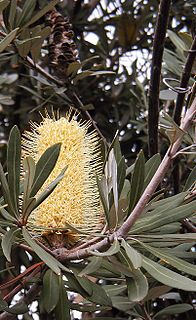
The taxonomy of Banksia integrifolia has a long and complex history, the result of confusion caused by the species' great variability, and similarities with some closely related species. The existence of hybrids between B. integrifolia and related species as well as early attempts to classify the species based on dried specimen material have also contributed to the confusion.

Banksia integrifolia subsp. compar is a subspecies of Banksia integrifolia. It has larger, glossier leaves than other subspecies, and occurs much further north.

Maireana is a genus of around 57 species of perennial shrubs and herbs in the family Amaranthaceae which are endemic to Australia. Species in this genus were formerly classified within the genus Kochia. The genus was described in 1840 by the botanist, Moquin-Tandon and named to honour Joseph François Maire (1780-1867), an amateur botanist who befriended him during the author's first visit to Paris in 1834.
Conospermum acerosum, commonly known as needle-leaved smokebush, is a shrub endemic to Western Australia
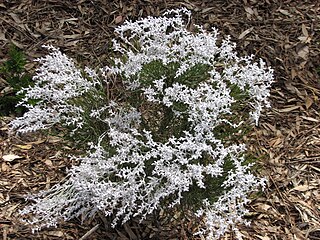
Conospermum stoechadis, commonly known as common smokebush, is a shrub endemic to Western Australia.

Grevillea manglesii is a shrub which is endemic to an area around Perth in Western Australia. It usually grows to around 3 metres in height and 4 metres in width and produces white flowers throughout the year.
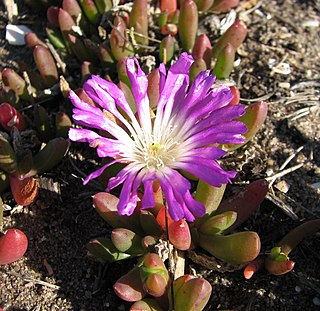
Disphyma crassifolium subsp. clavellatum is the subspecies of Disphyma crassifolium that occurs in Australia and New Zealand. It is sometimes known by the common name rounded noon-flower
Atriplex bunburyana, commonly known as silver saltbush, is a species of saltbush endemic to Western Australia.
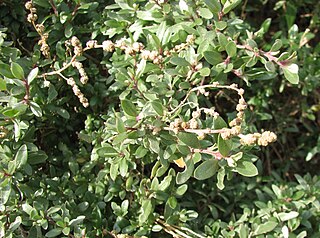
Atriplex paludosa, commonly known as marsh saltbush, is a species of saltbush endemic to Australia.
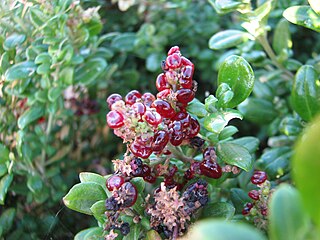
Chenopodium candolleanum, commonly known as seaberry saltbush, is a shrub in the subfamily Chenopodioideae of the family Amaranthaceae, native to Australia.
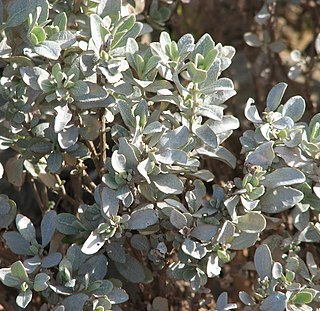
Atriplex vesicaria, commonly known as bladder saltbush, is a species of saltbush endemic to Australia.
Atriplex vesicaria subsp. variabilis is subspecies of bladder saltbush endemic to Australia.

Chenopodium baccatum, commonly known as berry saltbush, is a species of shrub endemic to Western Australia.
Nicotiana occidentalis, commonly known as native tobacco, is a short-lived herb native to Australia.

Stylidium affine is a species in the genus Stylidium that is endemic to Western Australia.

Persoonia muelleri, commonly known as Mueller’s geebung, is a shrub endemic to Tasmania. It forms a shrub in open areas of wet forests in the west and northeast of the state. It is occasionally confused with P. gunnii though it has larger flowers and longer, straighter leaves.

Grevillea ramosissima, commonly known as fan grevillea, is a shrub species of the family Proteaceae. It is native to south-eastern Australia.

Chenopodium desertorum, common name frosted goosefruit, is a species of flowering plant in the family Amaranthaceae, indigenous to Australia where it is found in all mainland states.
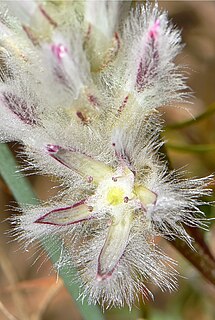
Ptilotus pyramidatus, the pyramid mulla mulla, is a small white herb in the family Amaranthaceae.
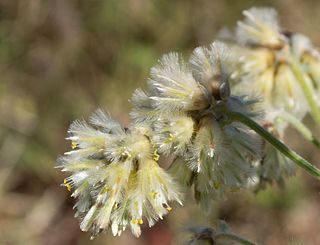
Ptilotus auriculifolius is a grass-like plant in the Amaranthaceae family.














